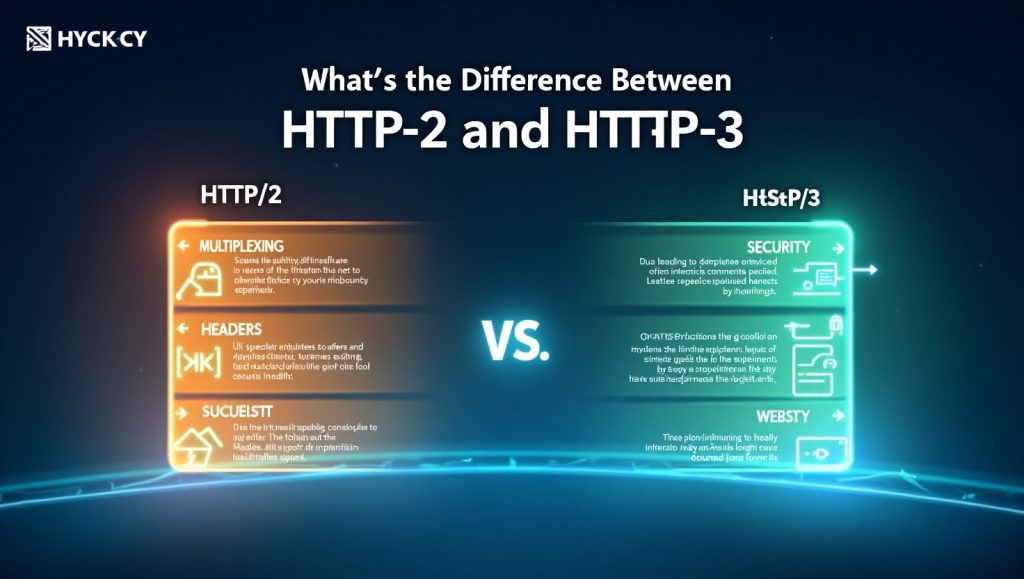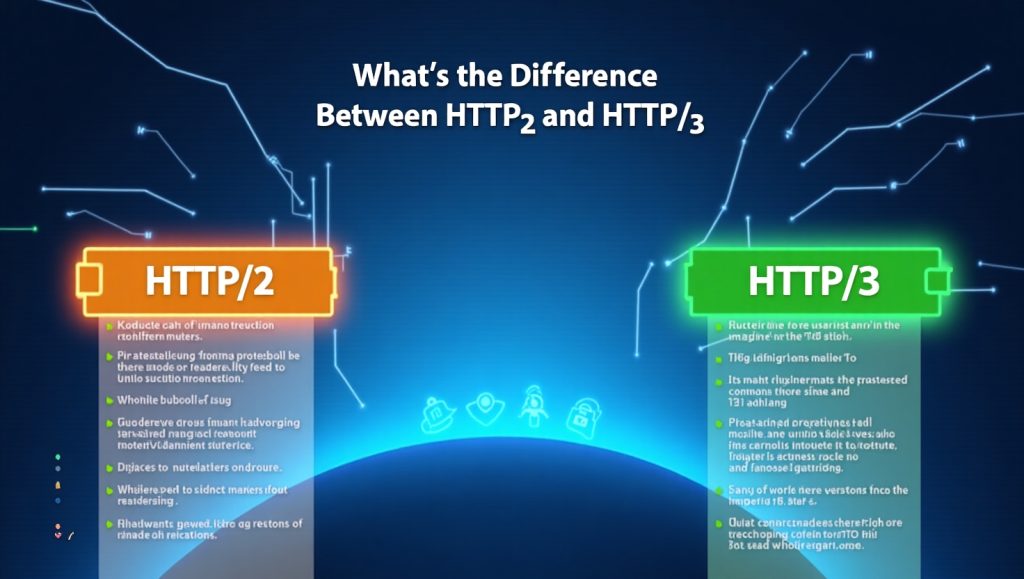
The internet is based on speed, effectively, and security. Those three needs and modern protocols like HTTP/2 and HTTP/3 are attempting to meet those needs. HTTP is almost always the protocol in between interactions that occur on a website; it essentially enables communication from a web browser to a server. HTTP/1.1 existed for over 15 years, but as more people began to surf the web, and load speed became more important (and mobile became truly mobile), HTTP/2 came out. Eventually came HTTP/3, which was a completely reworked version of how data moves across the web.
It’s important to know the difference between HTTP/2 and HTTP/3 because it will have an impact on your website(s) performance, especially if you are running content-heavy sites or for ever-changing global audiences. HTTP/2 had improvements to move more data at the same time, and other efficiency improvements using multiplexing, header compression, and server push. However, HTTP/2 was still based on TCP, which has its own limitations, including head-of-line blocking. If an item in the data stream is delayed then all the other items in the data stream are delayed.
HTTP/3 is based on QUIC, which was developed by Google and transmits over UDP, allowing for a more flexible, faster communication path, and better experience for users with mobile environments where networks could be unreliable. HTTP/3 improves connection handshakes, smooths out data recovery, and overall
HTTP/2 – Faster But Still Bound to TCP
The introduction of HTTP/2, in 2015, was a big improvement for the web, compared to HTTP/1.1 which had been around for observation since 1997. Originally, HTTP/2 was focused on making websites load faster without requiring changes to how websites are made. HTTP/2 was hoping this, and it was able to do it through some clever additions to the underlying transport ma mechanics, but still making use of the aging TCP protocol, which brings its own limitations.
One of the main things HTTP/2 introduced was multiplexing. In HTTP/1.1, when web browsers would request files from the server, they could only submit a limited amount of requests at a time to the server, commonly 6 per domain. This caused delays especially for websites with lots of images or loaded scripts. Instead of sending requests for a file and waiting for a response, HTTP/2 eliminated these delays by allowing files to be sent and received simultaneously over a single TCP connection. This made page loads much faster.
One of the other improvements was header compression. HTTP/1.1 repeated the headers unnecessarily for every request and wasted bandwidth unnecessarily. HTTP/2 introduced HPACK compression in order to cut down on redundant transmissions. HTTP/2 also introduced server push which allows the server to guess what the browser needs to continue to the next stage and pushes those resources before the browser even asks for the response.
However, HTTP/2 suffers from head-of-line blocking, because it still runs over TCP, meaning that if a packet is lost or delayed, everything behind it in the queue has to wait, regardless of whether those packets were received just fine. For users that are on high-latency or unreliable networks (especially mobile), this can lead to load times that are slower than intended.
And, as great as it is, HTTP/2 is still prevalent and supported by all major browsers. It represents a significant step forward for efficiency on the web, but it is phenom sheet how much TCP is still holding it back from the real-time responsiveness, that modern websites demand.
HTTP/3 – Built for Speed and Reliability
HTTP/3 is more than an upgrade; it is a paradigm shift. By moving away from TCP and utilizing a new protocol called QUIC, HTTP/3 offers a wealth of performance and reliability advantages especially for users on slow connections or for mobile users. QUIC (Quick UDP Internet Connections), originally a Google project, uses a transport mechanism called UDP, and QUIC can transmit data faster with fewer interruptions than TCP.
One of the main advantages of HTTP/3, and more specifically QUIC, is lack of head of line blocking. In TCP, if packet 10 is lost, packet 11 needs to wait until packet 10 is received. Packet 10 blocks everything after it. QUIC has independent streams of data; one lost packet won’t hold up everything else. This is huge, and impacts user experience positively, especially when working with a poor network connection.
Fast Handshake, as a benefit to the user, is also important. TCP requires a three-step process to establish a secured connection. QUIC combines the handshake and secure information transfer into one step. QUIC therefore has better latency and faster perceived initial load times than TCP based HTTPS. This is fantastic for sites looking to improve their conversion rates: e-commerce stores or site design Swansea companies sprouting up all over the place.
HTTP/3 also improves connection migration. If a user switches from Wi-Fi to mobile data (which happens a lot!), HTTP/3 can maintain the session without restarting the entire connection. This is a game-changer for mobile-first web strategies and users in areas with unstable connections.
It’s worth noting that HTTP/3 is still being gradually adopted. While major browsers like Chrome and Firefox support it, not all servers and CDNs have fully implemented it. Still, developers and digital marketers should prepare their infrastructure for HTTP/3. The performance gains and improved user experience make it a smart move, especially in competitive digital spaces where speed impacts rankings, conversions, and satisfaction.
Key Differences Between HTTP/2 and HTTP/3
Even though both HTTP/2 and HTTP/3 strive for a faster web experience, how they achieve that goal differs greatly. The main difference is the transport protocol. HTTP/2 is implemented on TCP, a reliable but older protocol commonly used for such things as web pages, that guarantees that content will be delivered in order. HTTP/3, uses QUIC, over UDP. UDP is also reliable, but QUIC avoids much of the limitations of TCP, offering substantial improvements while keeping reliability and encryption intact.
One prominent difference is in how they handle packet loss. In HTTP/2 if a packet is lost, that packet stops everything that comes after it, until it is re-transmitted. This is called head-of-line blocking, and is a huge contributor to slow performance on websites. HTTP/3 completely resolves this issue with its multiplexing capabilities of QUIC. QUIC provides the ability to multiplex multiple independent data streams across one connection. If one packet gets delayed, only that packet is delayed, not the rest.
Another major difference is the way they initiate connections. HTTP/3 uses a 0-RTT (Zero Round Trip Time) handshake which effectively starts sending encrypted data immediately or almost immediately. This gets it’s, extremely quick, encrypted, secure connections. HTTP/2 uses TCP, which means we have to set up a reliable TCP connection to start. Also, HTTP/2 uses TLS to set up a secure layer on top of the TCP connection, and this is simply slower to setup. This is exceptionally more apparent during long latency, especially mobile, connections.
When Should You Use HTTP/2 vs HTTP/3?

Selecting between HTTP/2 and HTTP/3 isn’t just a matter of using the latest technology. It isn’t a one-size-fits-all decision; it relies on your site’s needs, your audience’s location and devices, and the server infrastructure you’re using. In most cases, the best approach is to support both protocols and let the client connect using the most efficient one.
If you’re just working with normal infrastructure without support for HTTP/3 or QUIC, use HTTP/2. It’s something that almost every major browser and content delivery network supports. For sites hosted on normal shared hosting accounts or standard VPS accounts without advanced configuration, HTTP/2 is likely already enabled (it probably just used to use HTTP/1.1!). It’s stable, it’s reliable, and it’s a tremendous improvement over HTTP/1.1.
If performance and reliability are mission-critical—as in mobile-first experiences, international audience, and interactive web apps—then HTTP/3 wins, hands down. The consideration of being able to maintain sessions even when the user changes connections (for instance from Wi-Fi to mobile) is a huge benefit. If your analytics show high traffic from countries with not-so-stable connections or high traffic from users on mobile devices, switching to HTTP/3 might yield some substantial performance results.
For businesses offering website design Cardiff or performance-focused SEO services, HTTP/3 is a strong value proposition. It offers faster handshakes, smoother delivery, and better user experience across devices. That means lower bounce rates, faster engagement, and possibly better rankings—since speed is a known SEO factor.
The good news is many modern CDNs (like Cloudflare) offer HTTP/3 with a simple toggle. You don’t have to choose one or the other—both can be active, and the browser will choose the best option.
How to Prepare Your Site for HTTP/3
Getting your website ready for HTTP/3 doesn’t have to be complicated. In fact, most of the heavy lifting is done by your hosting provider or CDN. But there are still a few steps you should follow to ensure your site can take full advantage of HTTP/3’s performance benefits.
First, check if your web server or CDN supports HTTP/3. Services like Cloudflare, LiteSpeed, and Fastly already support HTTP/3, and they make it incredibly easy to enable. On Cloudflare, for example, it’s just a matter of flipping a switch in your dashboard. If you’re using a hosting provider, check with their support or documentation to see if HTTP/3 is available and how to enable it.
Next, use tools like Geekflare’s HTTP/3 tester or Chrome DevTools to test your site. These tools show if your site is accessible via HTTP/3 and whether fallback protocols like HTTP/2 are in place. This ensures users with older browsers can still access your content seamlessly.
It’s also wise to update your TLS settings, since HTTP/3 requires TLS 1.3. Many modern servers already support this, but if you’re using outdated SSL configurations, you’ll want to fix that. SSL certification and up-to-date encryption help keep your data secure and meet Google’s best practices.
Conclusion
It is crucial to understand the distinction between HTTP/2 and HTTP/3 for anyone interested in site speed, good user experience, andlong-term digital planning. While HTTP/2 already narrows the gap from HTTP/1.1 with many benefits—HTTP/3 takes the web further along by leveraging the QUIC protocol, using faster handshakes and improved performance when networks are poor.
It is a challenge for businesses, developers, and digital marketers because the decision is often not about one or the other, but about successfully implementing both so that users receive the best experience regardless of their browser or network environment. The good news is implementing HTTP/3 is becoming easier—especially through modern CDNs and the latest hosting services.
When you are taking a large scale eCommerce platform or even launching a local service site as a quick website design services or speed-optimized build website project, jumping onto HTTP/3 shows that you are ahead of the game. Speed has an important impact on outcomes for SEO, user satisfaction, and conversions, and HTTP/3 looks to help on all fronts and make the process just a little faster.